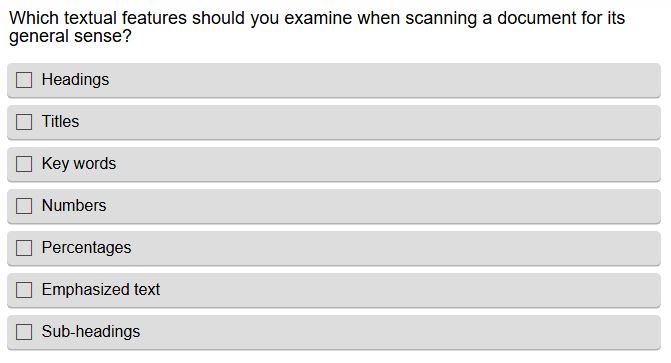3.2 Scanning
Erin Thomas, MFA
Scanning
Both skimming and scanning are types of fast reading. Scanning is different from skimming because instead of trying to get a general understanding of a text, you are trying to find particular bits of information. It’s important before scanning to select a key phrase or word that you are looking for. You fix this word or phrase in your mind, and then move quickly over the surface of a text looking for that word.
You probably scan more than you are aware of. Sometimes when you are looking for a location, you scan over the names of several businesses in a strip mall, looking for the right one. When you are looking at an event invitation, you may scan over the text looking for the time or the address. In this case, you would be looking for abbreviations like “p.m.” or know that you were looking for a number.
Scanning is often used in an academic setting. You may scan over a Chemistry textbook chapter looking for the definition of “oxidation” or a History textbook looking for information on the “War of 1812.” Scanning can help you locate specific information quickly. You can also use scanning for research when you are looking for a key term in research article titles or the body of a research article text.

Instructions
The following scanning exercises are designed for Boys in the Boat by Daniel James Brown.
Exercise 1
- Turn to Chapter Twelve in Boys in the Boat (pg. 207 Penguin 2013 version).
- You will be scanning pgs. 207-209 for the following information about Germany’s preparations for the 1936 Olympics.
- Identify a key word in each of the questions below. Hold this key word in your mind as you scan for the answer. Post your answers in the discussion string.
- How many acres was Reichssportfeld?
- How many people could fit in the Olympic stadium?
- How tall was the limestone tower?
- What was the inscription on the bell? (in English)
- In what community would the rowing competition take place?
- Additionally, answer the following questions in the discussion string from your own perspective:
- Have you been using scanning in your classes this semester? If so, what is your experience? How has it helped you?
- Have you used scanning as a rereading technique this semester with Boys in the Boat? How could scanning help you fulfill your weekly Boys in the Boat assignments?
- You may read your classmate’s comments after posting, but you are not required to comment.
Exercise 2
- urn to Chapter Thirteen and Chapter Fourteen in Boys in the Boat (pgs. 229-273 Penguin 2013 version).
- You will be skimming and scanning pgs. 231-233 for the following information about Bobby Moch, the boat number two coxswain.
- When you scan, you will identify a key word or type of word to search for (ex: when it’s a number, you search for a number). Hold this key word in your mind as you scan for the answer. Post your answers in the discussion string. When you skim, you will start by identifying a key word, and then once you find the correct passage, you will skim to find the relevant details. All the questions are in order. Only answers that come directly from the book will be given credit. Don’t use outside sources.
- How tall and how many pounds is Bobby?
- How did coxswains keep their weight down according to this text?
- Why were the wooden dowels called knockers according to this text?
- Why is the coxswain the captain of the rowing team. What are 2-3 responsibilities of the coxswain according to this text?
- Where did Bobby grow up?
- What did Bobby’s father do?
- What sports did Bobby play growing up?
- What honor did he receive at his high school?
- Did the other boys like Bobby? Explain.
- Additionally, answer the following question in the discussion string from your own perspective:
- Did you feel comfortable switching back and forth between skimming and scanning to find the correct answer? Explain.
- You may read your classmate’s comments after posting, but you are not required to comment.
Media Attributions
- Scanning © Patricia Williamson is licensed under a CC BY-NC-SA (Attribution NonCommercial ShareAlike) license

